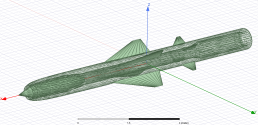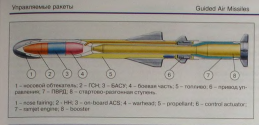Russia's strike weapons are FAB-500M62 gliding bombs. Russian aviation began to actively use the FAB-500M62 aerial bomb, equipped with a planning module; it became the main weapon of the Russian army. The advantages of aerial bombs with gliding modules are that the mass of the combat load in the bomb reaches approximately 70% of the launch mass, while in a similar rocket it is only 15-20%. Examples of using a bomb are in the link to the video in the comments to the video. The FAB-500 M62 high-explosive bomb was put into service in 1962 and contains 213 explosives. The bomb is simple in design and made of cast iron, while the cost of the FAB-500 M62 bomb is only 300 thousand rubles or $3,100. The height of bomb release is usually from 570 meters to 12 kilometers, with a release speed from 500 to 1900 km/h. The use of this bomb with a planning module allows for strikes at ranges of up to 70 kilometers. After the bomb explodes, a crater is left up to 8 meters in diameter and 3 meters deep. The radius of the bomb is about 250 meters.
You are using an out of date browser. It may not display this or other websites correctly.
You should upgrade or use an alternative browser.
You should upgrade or use an alternative browser.
Russian Military News, Reports, Data, etc.
- Thread starter tphuang
- Start date
Modernization of KAB-500 adjustable aerial bombs. Russia will improve the adjustable aerial bombs of the KAB-500 series, this was announced by the director of the Tactical Missile Weapons Corporation, interview at the end of the video. Now Russian aviation uses adjustable aerial bombs KAB-500S-E, it is worth noting that they are rarely used, perhaps due to the cost of the KAB-500S bomb, it is about 3 million rubles or 30,000 dollars, or a short release range of up to 9 kilometers. The bomb was developed in 2000 and is designed to destroy large stationary ground and surface targets. KAB-500S-E is guided by GLONASS and GPS coordinates, which are entered on the ground or can be specified from the carrier in preparation for the reset. The mass of the bomb is 560 kg, the mass of the high-explosive part is 460 kg. The permissible altitude for dropping a bomb is from 500 meters to 10 kilometers, the speed of the carrier aircraft when dropping a bomb is from 550 to 1100 km/h. The bomb hits targets with a probable circular deviation of no more than 10 meters.
Military training of former Russian prisoners. Video of military training, Russian recruits of the "North" unit, consisting of former prisoners. Soldiers are trained by instructors from the 200th separate guards motorized rifle brigade of the Russian Northern Fleet.
Some stuff i did on Oniks/Yakhont. Basically estimating the RCS from VHF down to mm wave band (150 MHz to 36 GHz)
The missile is modeled, which includes the internal inlet.

Although bigger than most Russian or Western AShM, Oniks is internally simple with almost no moving part. The fuel are stored around the large central inlet. The central inlet and central part of the 3D55 Ramjet engine basically become space for large ejectable solid rocket booster.

Therefore there isnt much for Radar wave to reflect into if it gets inside.
The following is the contour plot of the RCS :
The result in "spherical equivalent RCS" Which basically doubles of Median. Comparison with Kalibr is also included.

Might be bit surprising but the reason for that is Kalibr's large unswept wing. Still however notice that both cruise missile are Below 1 sqm. It's just that Oniks are much faster.
The missile is modeled, which includes the internal inlet.

Although bigger than most Russian or Western AShM, Oniks is internally simple with almost no moving part. The fuel are stored around the large central inlet. The central inlet and central part of the 3D55 Ramjet engine basically become space for large ejectable solid rocket booster.

Therefore there isnt much for Radar wave to reflect into if it gets inside.
The following is the contour plot of the RCS :
The result in "spherical equivalent RCS" Which basically doubles of Median. Comparison with Kalibr is also included.

Might be bit surprising but the reason for that is Kalibr's large unswept wing. Still however notice that both cruise missile are Below 1 sqm. It's just that Oniks are much faster.
Strictly speaking, Onyx doesn't represent 'largest' Soviet/Russian ASCM branches, it's the medium-heavy one(tactical/theater missile, as opposed to larger theater monster cousins - P-500/1000, P-700/1200 families).Although bigger than most Russian or Western AShM, Oniks is internally simple with almost no moving part. The fuel are stored around the large central inlet. The central inlet and central part of the 3D55 Ramjet engine basically become space for large ejectable solid rocket booster.
Larger branches are dying out now, however - even the late Soviet Union couldn't afford the next generation of their carrier ships and submarines. (curiously - it happens in parallel to the gradual rise of interest to oversized anti-ship solutions internationally).
Last edited:
The Russian army now has AODES Desertcross 800-3 buggies made in China. How the Desertcross 800-3 all-terrain vehicles came to be is unknown, data on them varies, some report that these were purchases from the Ministry of Defense, other sources say that the buggies were purchased with private funds. Despite their apparent simplicity, soldiers really need these machines. The buggies weigh 849 kg and are equipped with a 60 hp engine. and have a load capacity of 300 kg. The all-terrain vehicle can carry 3 people. The approximate price in Russia of the Desertcross 800-3 buggy is 1,650,000 rubles or 17 thousand dollars.
Testing the Triton electronic warfare system of the PPSh company, protecting tanks from drones. The Russian company PPSh has developed the Triton electronic warfare system to protect tanks from FPV drones. Published a promotional video for testing the Triton complex. The complex can be installed on tanks and other equipment, it can also protect infantry positions and even be installed on trees. According to the test scenario, an FPV drone is chasing an ATV; judging by the video, the Triton complex was able to suppress the drone’s control channels. As it has now become known, the Triton electronic warfare system operates in 9 ranges, from 400 to 5600 MHz, most likely the complex can change operating frequencies.
